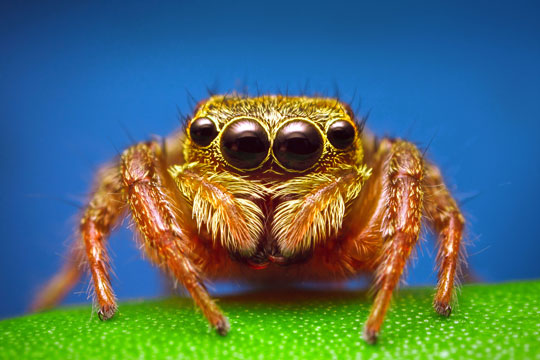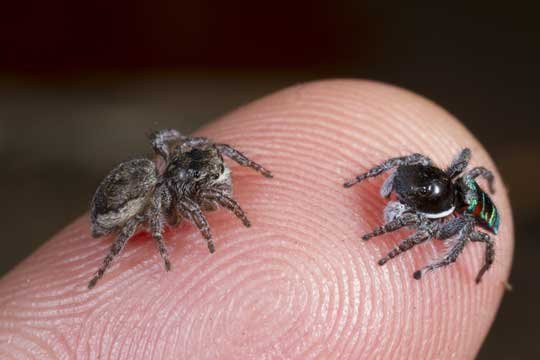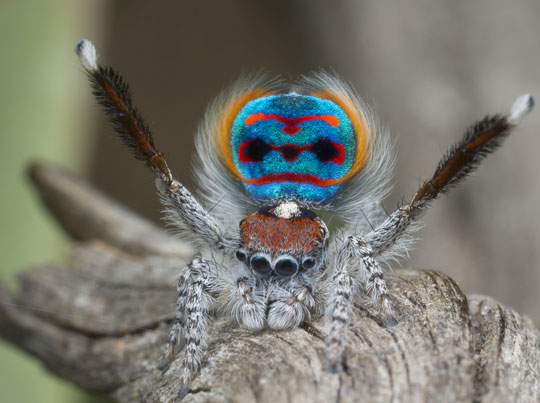|
I know... many people hate spiders. I get it. However, jumping spiders are different. They're furry and, well, their faces are just darn cute! You know what jumping spiders are, right? They are those compact little fuzzballs with eight legs that crawl around with short bursts of speed. If you try to touch them, they disappear. Well, they don't actually disappear—they jump. They jump so quickly that often you hardly see them do it, and they seem to disappear. And when you look really closely... those eyes! What the heck is a Jumping Spider? Jumping spiders make up the family Salticidae. Astoundingly, there are over 6,000 species that we know of so far! Yep, six thousand—it's the largest family of spiders. I'd love to include a photo of each species, but I don't think that's going to happen. Jumping spiders, which are typically small, have highly-developed eyes, with better vision than almost all other arthropods (arthropods also include insects, crustaceans, scorpions, centipedes, and many other creatures with exoskeletons). Amazing Facts about Jumping Spiders Let's begin with these spiders' jumping ability. As I'm sure you can guess, this ability is important to the way they hunt their prey. A jumping spider spots a prey animal using its amazing eyes. Then it carefully approaches the creature, trying to decide if the prey is suitable as a meal. Before jumping on its prey, the spider attaches a filament of silk (called a dragline) to the surface it is standing on. Then the spider launches itself through the air to attack. Take a look at the legs of the spiders in the photos above—tiny little legs! Those aren't big, powerful legs like a grasshopper's hind legs. So, how does a jumping spider jump with such force? It's all about hydraulics. Jumping spiders have jointed legs, like we do, but their legs each have seven segments. Like humans, spiders have flexor and extensor muscles. Extensor muscles are the ones that can be contracted powerfully to extend a leg, allowing a creature like a grasshopper or a human to jump. The weird thing is, jumping spiders do not have extensor muscles at two of the seven joints of their legs—and these are the joints that give them their jumping power! So then how do they jump? Like I said, hydraulics. The jumping spider has the ability to force hemolymph (the spider's version of blood) out of its cephalothorax and into its legs. This sudden injection of blood into the legs causes the legs to straighten with great force, sending the spider flying through the air. They can jump up to 50 times the length of their own body. Pretty cool, huh? If the spider misses its prey, or if the prey struggles and shakes the jumping spider off, the spider can just climb back up its safety dragline to get back to where it started. Check out this video about how jumping spiders jump. We really need to talk about the jumping spider's eyes, which are perhaps their most impressive feature. Jumping spiders have four pairs of eyes, and each pair serves a different purpose. There are two pairs of small eyes on the sides of the head, and two pairs of larger eyes mounted in the front of the head (see below). On the sides of the head there is the pair of posterior medial eyes and a pair of posterior lateral eyes. The posterior medial pair don't really see distinct images—they just detect the level of available light. The posterior lateral pair are good at detecting motion to the sides and behind the spider, giving the spider almost 360° vision. It's the two pairs of front eyes that are most amazing, though. These are called the anterior lateral eyes (the two smaller ones), and the anterior medial eyes (the two large ones). The anterior lateral pair have good visual acuity, and they are spaced widely apart, helping the spider with depth perception. The anterior medial pair (the biggest eyes) have extremely good vision. The retinas of these eyes can actually swivel around on their own, so that the spider can look around without moving its head. These eyes are acute, and some jumping spiders have an astounding ability to see color details, even into the UV range. This gets a little complex, but I want to explain how these two big eyes help the spider estimate distance (which is important to a creature who likes to jump on its prey). These two eyes are too close together for depth perception, so jumping spiders have evolved a unique alternative called image defocus. It's all done with green light. Here's how it works: Incoming green light is focused on the deepest layer of the retina. So, green light passing through the surface layers of the retina is out of focus, or fuzzy. The spider is capable of measuring the amount of defocus (fuzziness) between the deep layer and the surface layers, and it uses that information to determine the distance of the object in front of its face. Wow! Okay we need to discuss one other amazing thing about jumping spiders—their elaborate mating rituals. The males have evolved spectacular dances and displays to try to impress a potential mate. We can divide these displays into two categories, those without color and those with color. You see, many jumping spiders are not capable of seeing a wide range of colors. Those species have elaborate dances, but it is mostly shuffling around, waving their legs in the air, and shaking their booty. Impressive, but... There are also some species of jumping spiders that can see colors. The males of those species take advantage of this, and they add colorful enhancements to their booty-shaking dances. The male peacock spider, for example, has a brightly-colored abdomen flap, which it flips up and down like a decorative flag. I could describe these mating dances all day long, but you wouldn't really get a feel for what they are like unless you see them in action. This video is a great way to witness the displays for yourself. Now, don't you agree there's more to jumping spiders than meets the eye? The next time you see one skittering around in your house, instead of smashing it, take a closer look. So, the Jumping Spider deserves a place in the G.E.A.H.O.F. (Gilt-Edged Animal Hall of Fame). FUN FACT: The term gilt-edged was first used in about 1810. Originally, the adjective gilt was another way to say gilded. Gild is a verb, meaning "to cover with a thin layer of gold." So, something that has been gilded is covered with a layer of gold, such as the pages of an old book having gilded edges. Gilt-edged originally meant the same thing as gilded. Eventually, people began using gilt-edged in business to refer to the safest kinds of investments (such as government bonds). And then, as often happens, people began to us the term to refer to anything of the highest quality. So, gilt-edged is another way to say awesome! Photo Credits:
Jumping Spider #1 - DepositPhotos Stock Images Two jumping spiders on finger - Jurgen Otto/University of Cincinnati Magazine Jumping spider leaping - Scott Linstead Jumping spider eyes - DepositPhotos Stock Images Jumping spider on green background - DepositPhotos Stock Images Peacock jumping spider - Jurgen Otto/University of Cincinnati Magazine
0 Comments
Leave a Reply. |
Stan's Cogitations
Everyone needs a creative outlet. That's why I write. Archives
July 2024
|







 RSS Feed
RSS Feed